Earlier this year, the San Francisco Public Press featured Gregory Nelson in “Driving Home: Surviving the Housing Crisis,” a photojournalism project by Yesica Prado documenting the experiences of people living in vehicles in the Bay Area. Prado followed up with Nelson to find out how his life has changed during the pandemic. Read the story that accompanies this photo essay, “Pandemic Makes Ride-Hailing Gig Untenable for S.F. Man Living in His Car.”
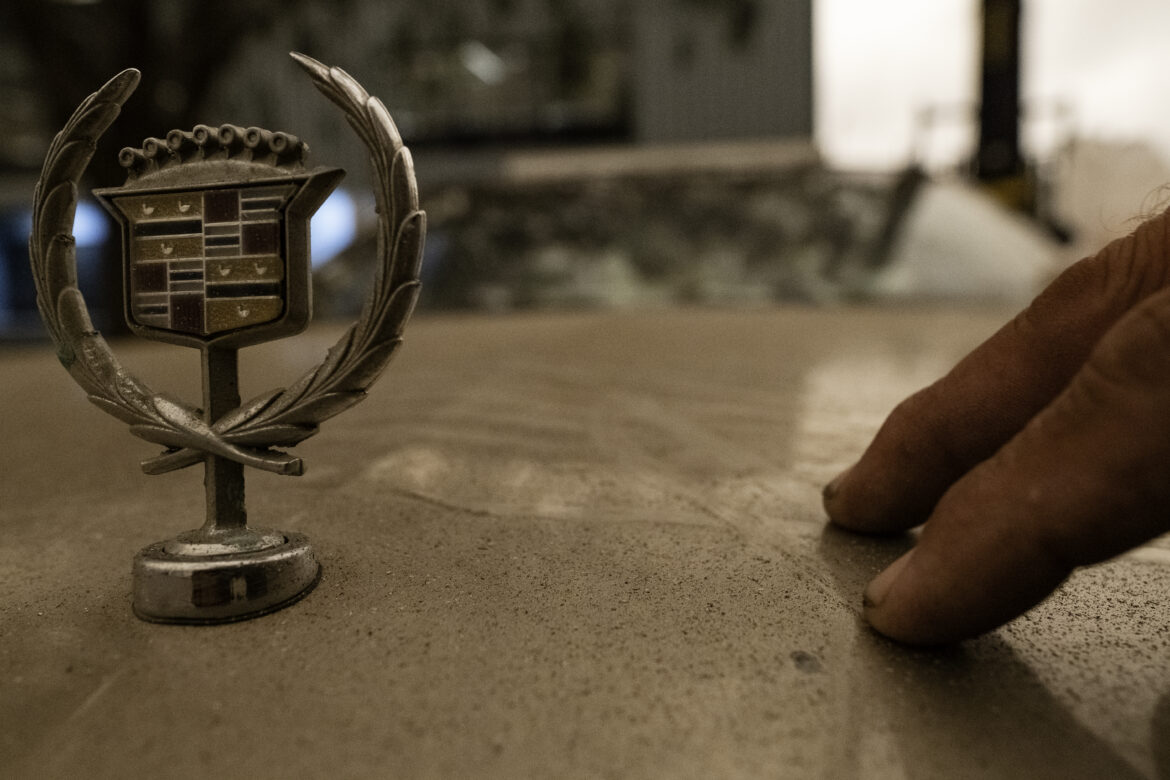
Yesica Prado / San Francisco Public Press and CatchLight Local
Gregory Nelson brushes his fingers across the hood of his vehicle, smudging the ashes that have settled on it in early September. “Look at all this dust,” Nelson said, raising his blackened fingers. “I just washed my car yesterday. Now, it’s on everything again. You cannot have anything nice out here.” On Sept. 9, some 14,000 firefighters were battling 28 major wildfires across California. And while the containment of August’s lightning fires seemed imminent, several new wildfires ignited and were fanned by strong gusty winds. Since the beginning of the year, more than 8,500 wildfires have burned over 4.1 million acres in California. To date, the total number of deaths due to wildfires statewide is 31, and nearly 10,500 structures have been destroyed. Thousands of wildfire evacuees are living in emergency shelters and inside their vehicles.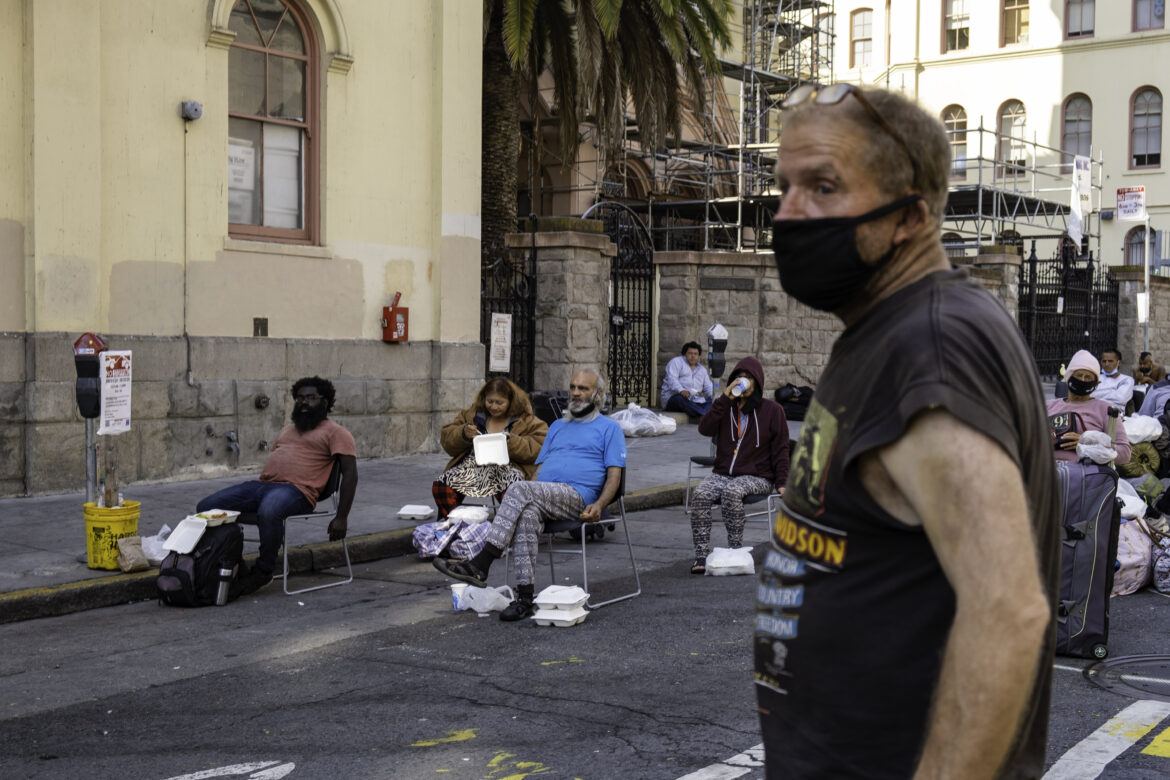
Yesica Prado / San Francisco Public Press and CatchLight Local
On a Sunday morning, Nelson walks three miles roundtrip between the tow yard where he keeps his car parked and the Tenderloin neighborhood, following a routine that involves picking up his breakfast at St. Anthony’s Dining Room. He passes people who have picked up meals and are eating them while sitting in chairs placed on the street by St. Anthony’s. The chairs are spaced six feet apart for social distancing to mitigate the spread of COVID-19. After the coronavirus pandemic began, service providers applied safety restrictions. No more open showers or restrooms. No more public seating to charge devices. No more dining rooms. Rather than claiming a chair on the street, Nelson prefers bringing his take-out food back to his car, and enjoys it in privacy.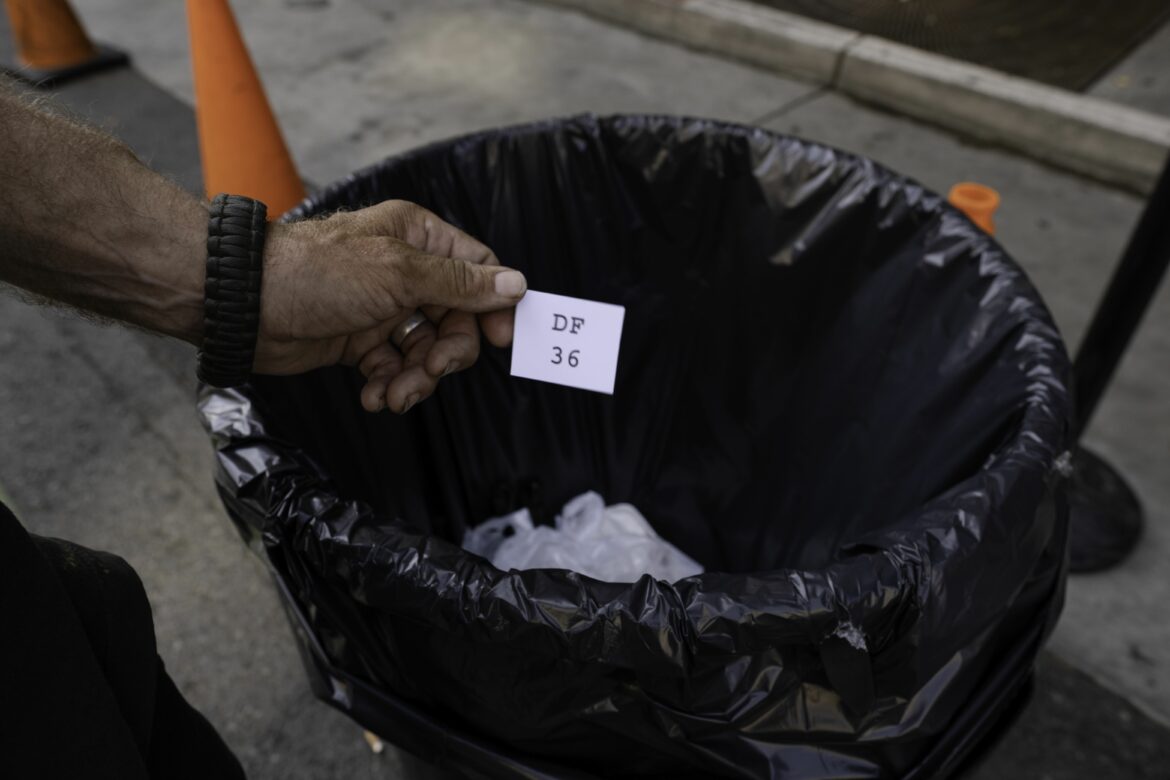
Yesica Prado / San Francisco Public Press and CatchLight Local
Nelson drops his paper meal voucher number in a trash can before picking up his takeout lunch box at St. Anthony’s Dining Room. Without a job or steady income, Nelson depends on local service providers for his daily meals. He’s a year too young to claim Social Security, and while Nelson is generally optimistic, he worries that his recent disability claim won’t be approved. “They might say it’s not severe enough or argue it,” Nelson said. “That’s their tactic. It’s just a delay, delay, delay. I guess they hope you’ll just go away or die or something before they have to pay.”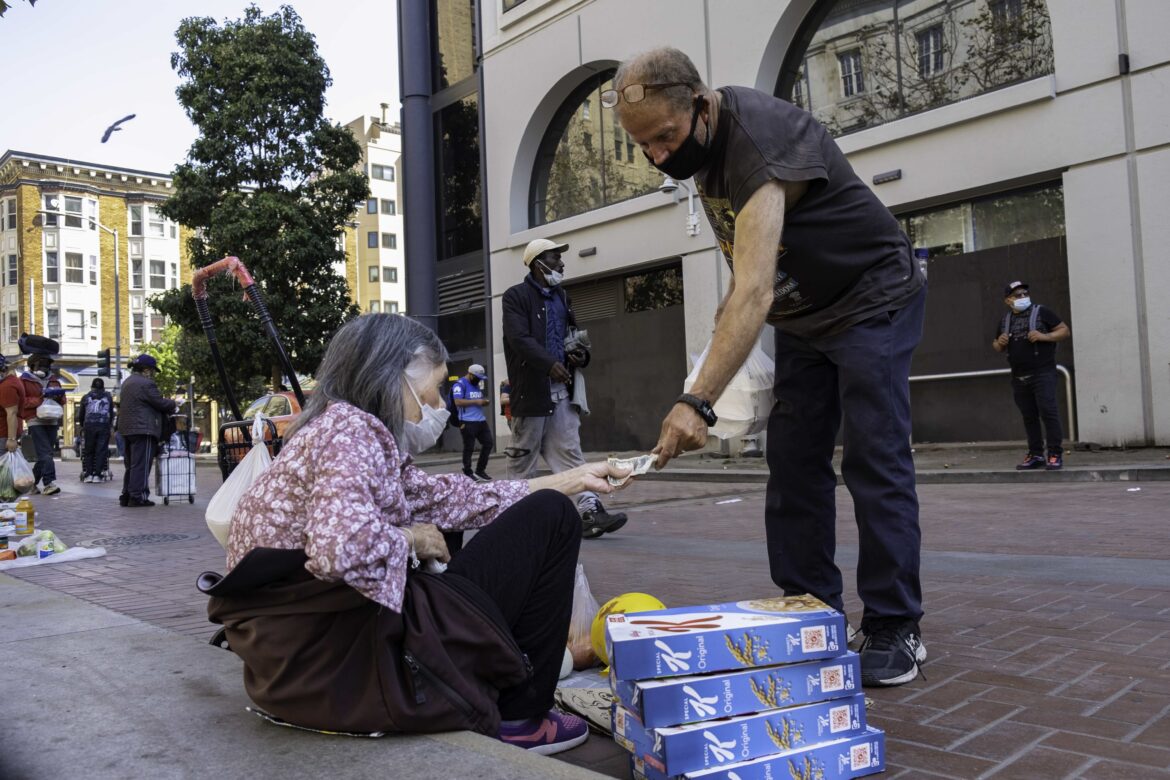
Yesica Prado / San Francisco Public Press and CatchLight Local
On a Sunday afternoon, Nelson walks through the farmer’s market at United Nations Plaza in the Civic Center and purchases a box of Girl Scout cookies for a dollar from a street vendor. Nelson recognizes the woman’s products from the local food bank site that he also visits. “They position themselves to intercept a dollar,” Nelson said. “Bring the money home to the family and go to the church and get some more. If there’s no resource to get more free food then they’re out picking up cans.”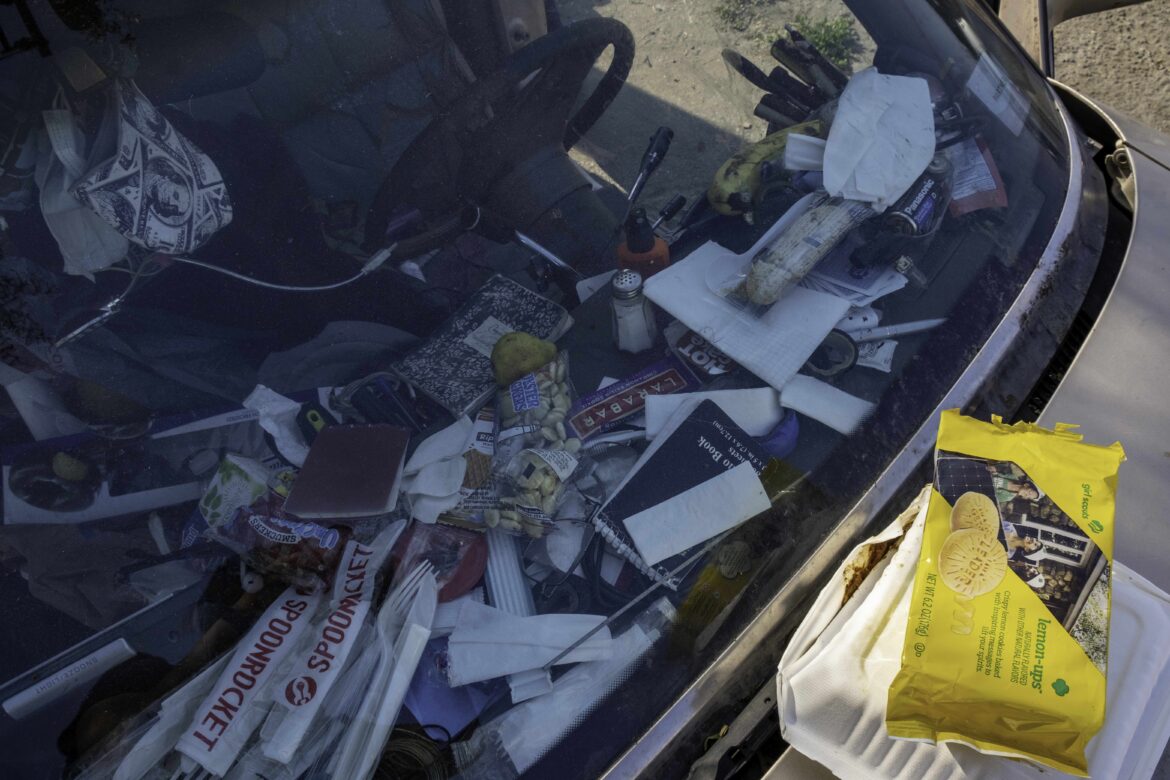
Yesica Prado / San Francisco Public Press and CatchLight Local
For the past year, Gregory Nelson’s home has been a 1986 Cadillac. During the shelter-in-place order, he spends most of his days hanging out inside his vehicle on the edge of the tow yard where he used to be employed and now does odd jobs. Nelson uses his vehicle’s dashboard to store small everyday essentials like snacks, utensils, batteries, pencils, notepads and masks.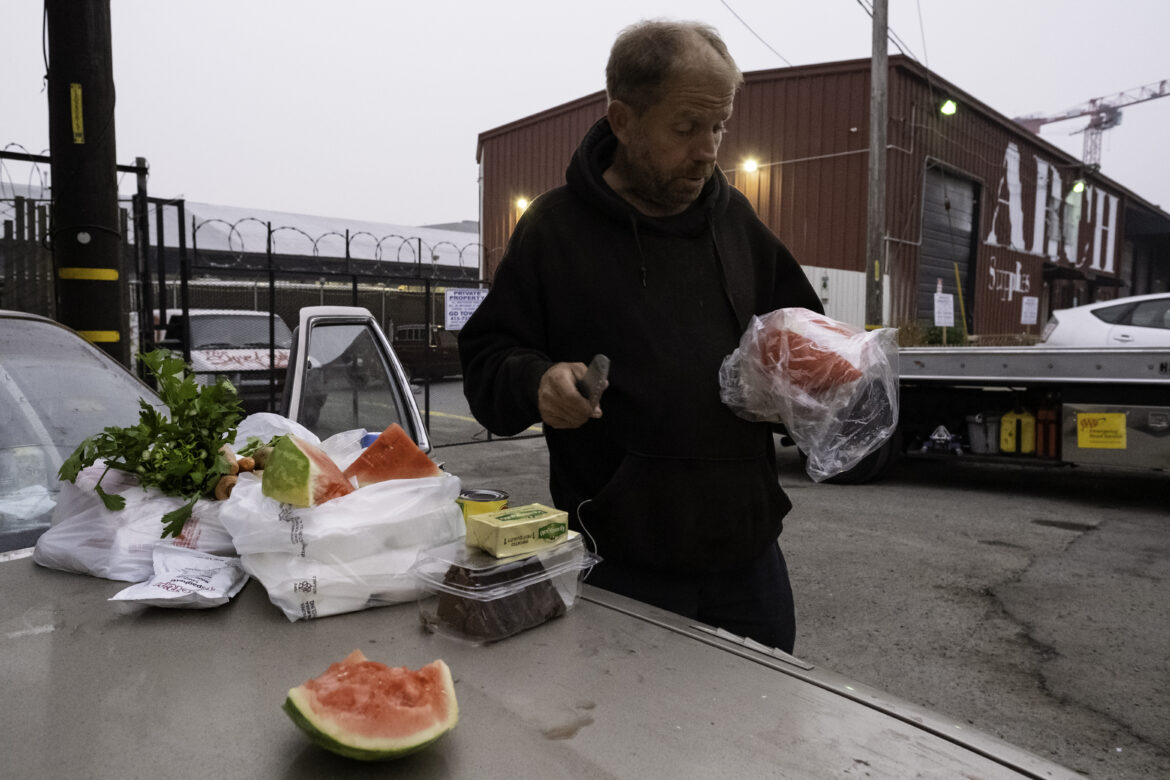
Yesica Prado / San Francisco Public Press and CatchLight Local
Nelson prepares dinner using groceries from a pop-up food bank site at Bessie Carmichael Elementary School in San Francisco. He picks up a weekly supply of groceries like vegetables, fruit and poultry, which allows him to prepare home-cooked meals once in a while. Nelson lays out all of his ingredients on his table, the hood of his vehicle, before deciding how he will use them. Quickly, he decided to cook the chicken, which would spoil if left in his car.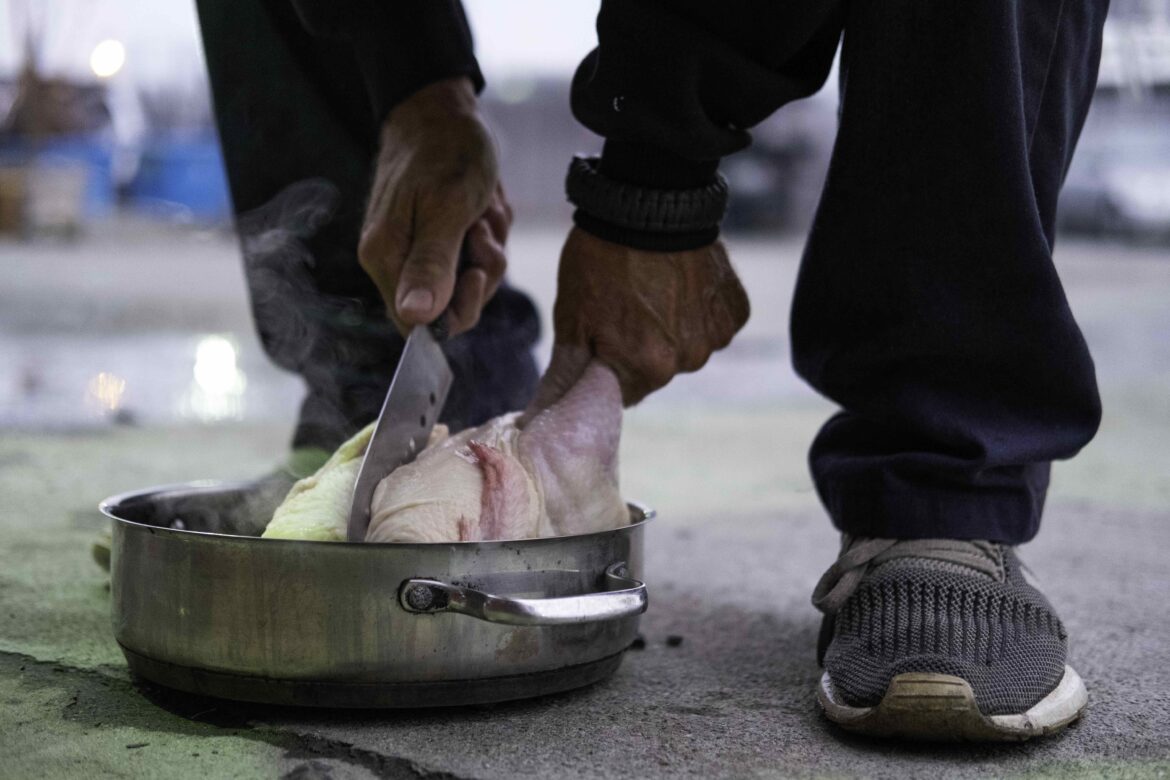
Yesica Prado / San Francisco Public Press and CatchLight Local
After quickly washing the poultry with a hose, Nelson slices a raw chicken in half and puts it in a stainless steel pot, adding thin onion slices for flavor. He uses his NuWave induction pan, to prevent any fire hazards from cooking outdoors. To stay low key, he also waits until the nearby art supply store closes for the day before he attaches the pan to an extension cord, which he plugs into an outlet in the tow yard office. He prefers to remain hidden from the shoppers and nearby students to maintain his safe parking spot.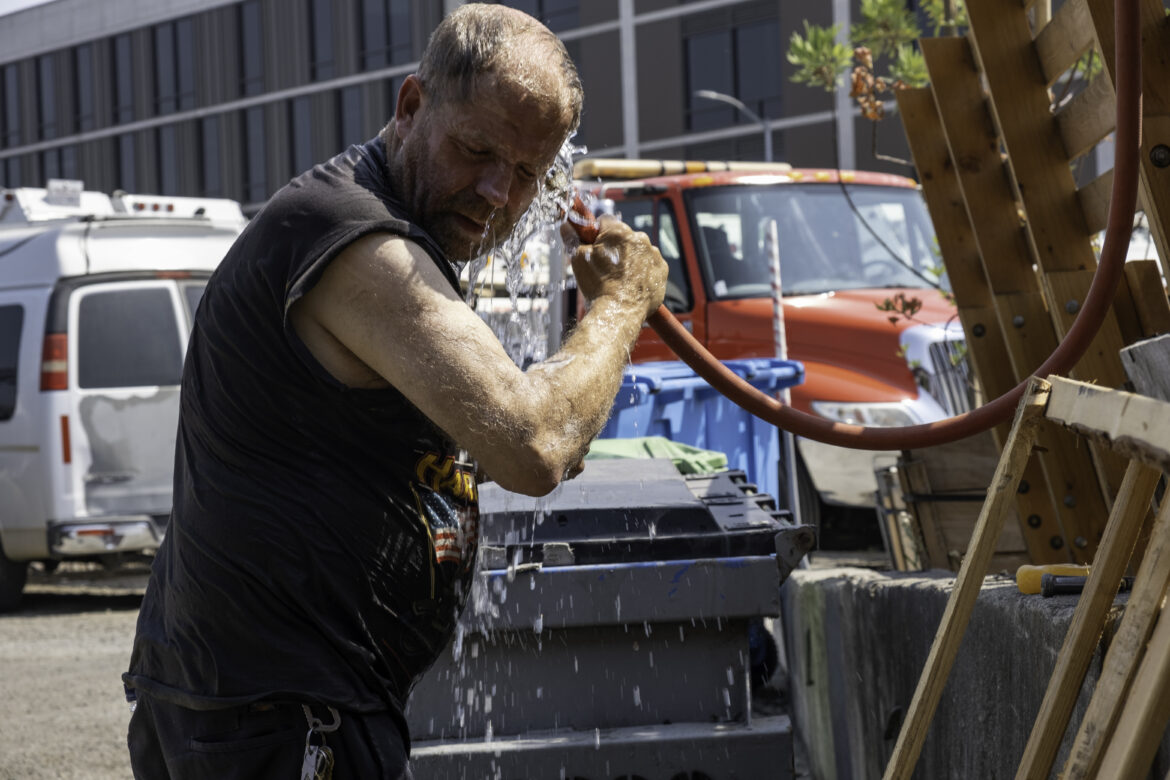
Yesica Prado / San Francisco Public Press and CatchLight Local
On a hot Sunday afternoon in late September, Nelson takes a cold shower using a hose at the tow yard. For Nelson, finding a shower is a daily puzzle. Some homeless service providers have reduced their operation hours, and others temporarily closed their shower services. No public gym showers. Nowhere to go. Nelson quickly bathes with his clothes on to prevent being spotted by passersby. He uses a bar of soap and air dries his clothes while wearing them. It’s too cold to shower with the hose at night, so he maintains his hygiene when no one is looking.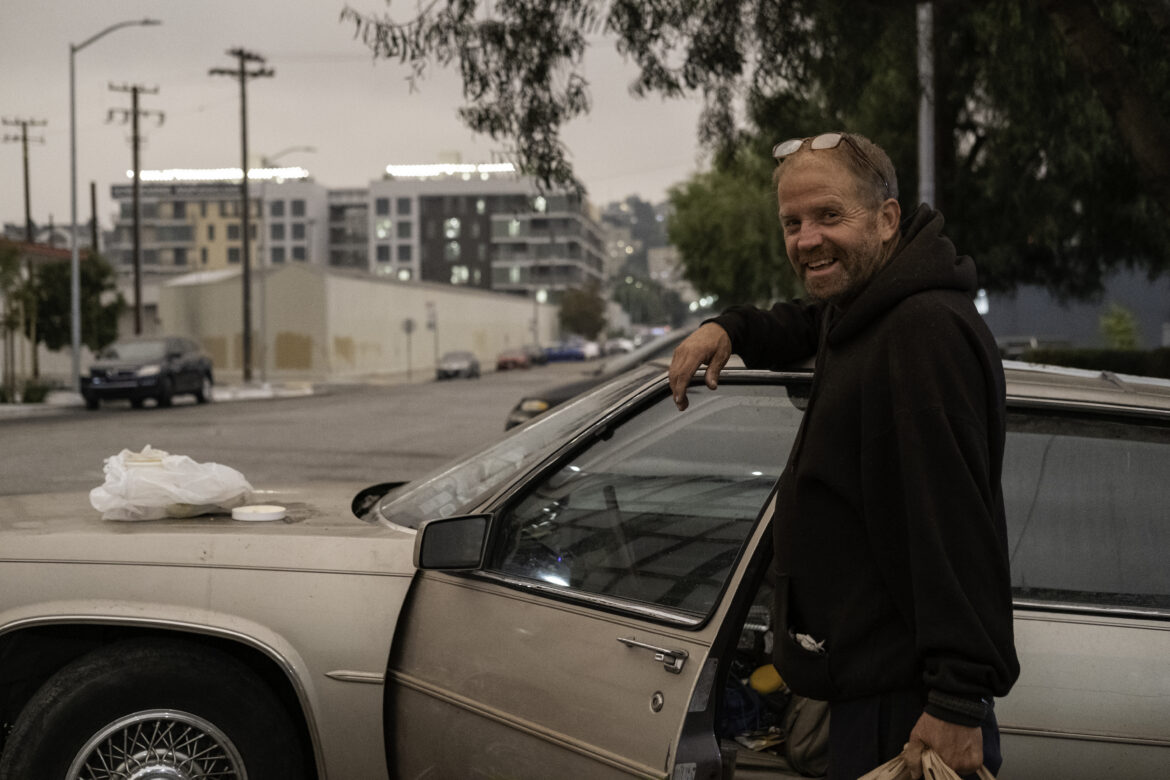
Yesica Prado / San Francisco Public Press and CatchLight Local
On Sept. 9, Gregory Nelson smiles for a portrait with his car on the edge of San Francisco’s Potrero Hill and Mission Bay neighborhoods. On this day, an orange sky glow falls on Bay Area residents, waiting for daylight hours to come. But a smokey sky followed for days. The North Complex fires brought more smoke and ashes, which gusty winds carried to Bay Area cities. As of Nov. 10, the North Complex fires had burned 318,935 acres, and the complex was 96% contained. It had caused 16 deaths, and 2,455 structures had been damaged or destroyed.
Yesica Prado / San Francisco Public Press and CatchLight Local
Nelson kicks back and relaxes inside his vehicle where he lives in San Francisco. He contemplates how to pay his bills this month. Without a steady income, even one parking ticket can be “devastating,” said Nelson. “A little stupid tic is going to turn into a $300 ticket or something like that.” Effective Sept. 1, SFMTA resumed enforcement of late penalty fees on parking and transit citations. Full payment of outstanding amounts, or protests, for parking or transit citations were due by Aug. 31. In the same way, street sweeping enforcement is in effect, but citations for 72-hour overtime parking limits continue to be suspended.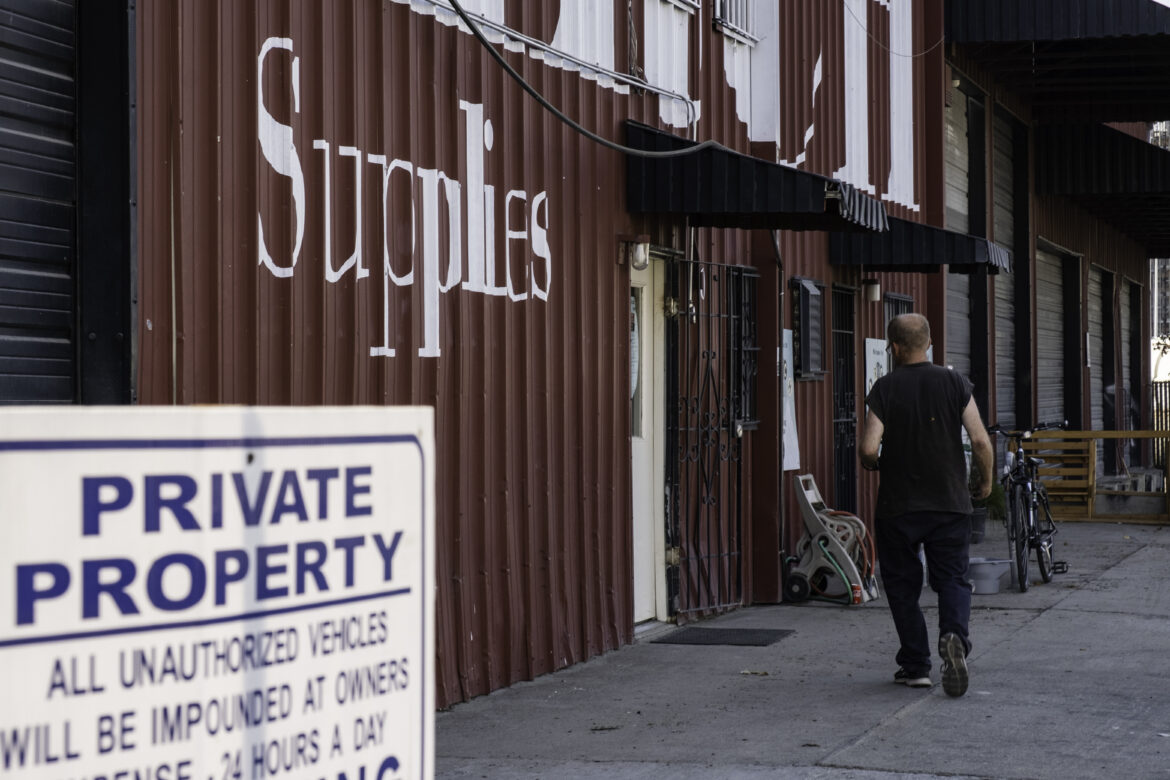
Yesica Prado / San Francisco Public Press and CatchLight Local
Nelson walks to the restroom in the tow yard’s office. His former co-workers allow him to use the premises as long as he remains relatively invisible to customers. Every day, it’s a hustle. “I’m getting annoyed at the constant game and constant pressure,” Nelson said. “I mean, I got it pretty good. Compared to so many. I got a car. I got good friends. Kick down a little bit here and there. Support. Smiles. Food. It’s the easiest place in the world to eat. People say, ‘they’re hungry.’ Not here. You know?”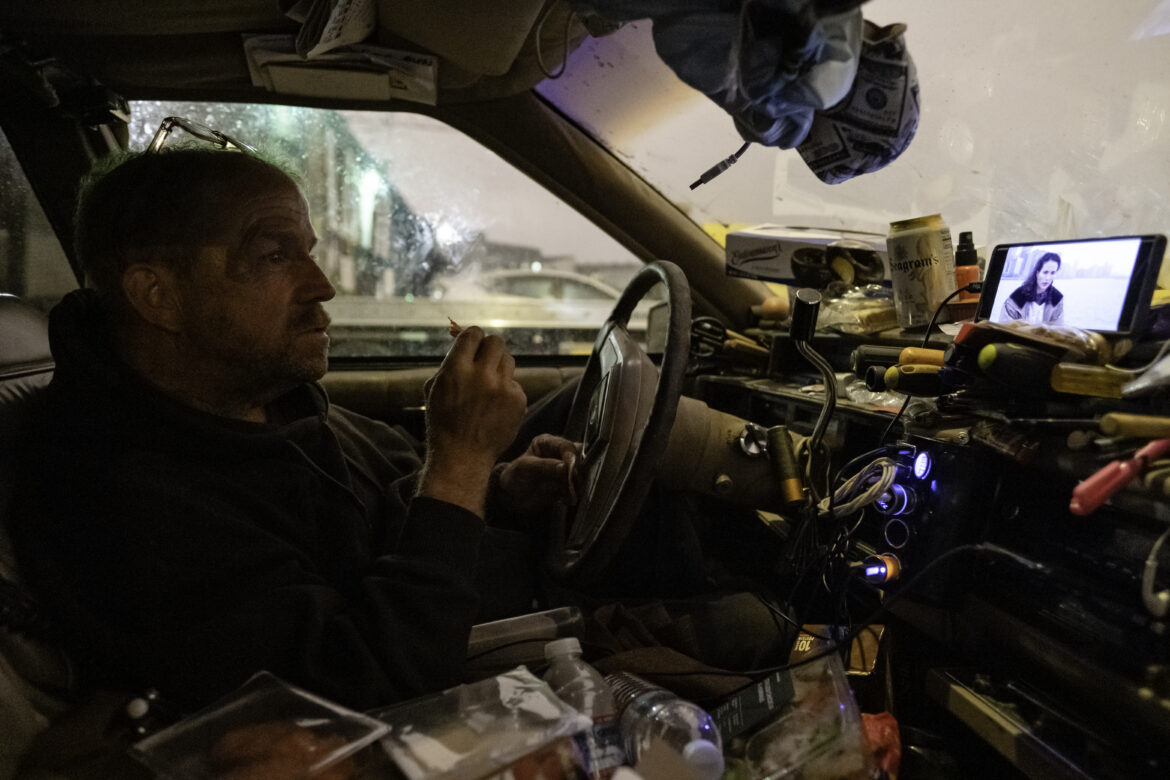
Yesica Prado / San Francisco Public Press and CatchLight Local
Nelson sits back on his driver seat inside his Cadillac, eating snacks while he watches one of his favorite ‘90’s movies — “Grosse Pointe Blank.” He enjoys the small pleasures of life like good music, watching movies or video clips on YouTube, and eating snacks like other people sheltering in place. His favorite comfort foods are chocolate milk and doughnuts.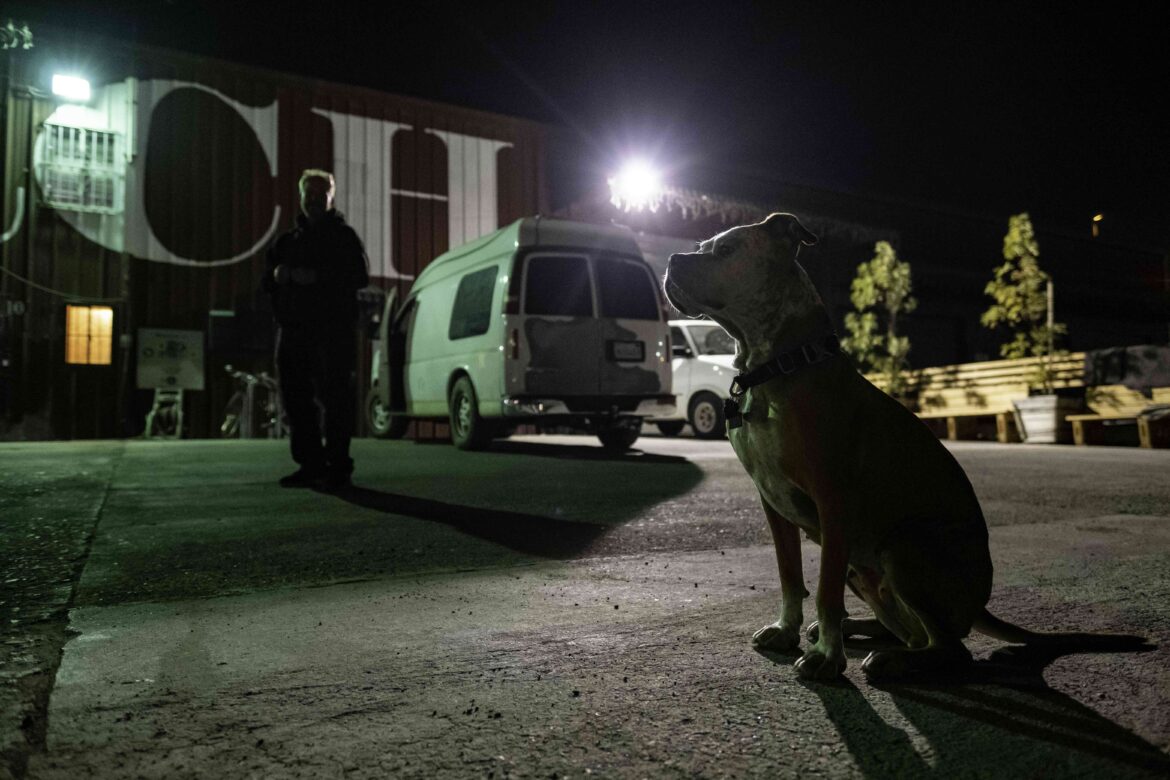
Yesica Prado / San Francisco Public Press and CatchLight Local
April, the tow yard guard dog, perks up her ears at the sound of nearby footsteps on Carolina Street. Nelson laughs at her sudden guard stance and how her bottom never touches the ground. During the pandemic, he gets to enjoy more of April’s companionship, spending most of his days parked down the street from the tow yard lot. Together, they watch over the premises and discourage people from trying to camp there or scan the tow yard’s vehicles for valuables. Every day, Nelson escorts someone off the lot. “April is my only girl,” Nelson said jokingly. “The only one that can stand me and follow me around. Everyone loves her, here. She knows this is her home.”This story is part of “Driving Home: Surviving the Housing Crisis” and was produced in collaboration with the Bay Area visual storytelling nonprofit CatchLight through its CatchLight Local Initiative. As a CatchLight Local Fellow at the San Francisco Public Press, Yesica Prado examined the culture of vehicle living in San Francisco and Berkeley. Her fellowship work has been featured by the Yerba Buena Center for the Arts and by the Artists Against an #Infodemic Campaign, which aims to improve access to locally relevant public health information. The CatchLight Local Initiative is funded by the Kresge Foundation, The GroundTruth Project, the Facebook Journalism Project, the Neda Nobari Foundation and the Lisa Stone Pritzker Family Foundation.
